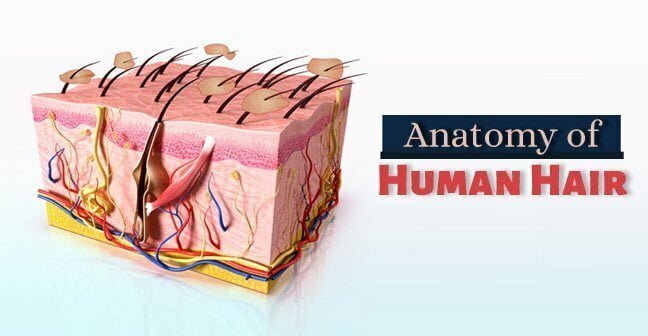Today we are discussing the anatomy of hair. Hair is found only in mammals, where during the course of evolution its primary roles were to serve as insulation and protection from the elements. However, in contemporary humans, hair’s main purpose revolves around its profound role in social interactions. Loss of hair (alopecia) and excessive hair growth in unwanted areas (hirsutism and hypertrichosis) can lead to significant psychological and emotional distress. So, Hair is simple in structure but has important functions in social functioning. Hair is made of a tough protein called keratin. Contrary to the popular belief that hair grows as single strands, hair follicles actually grow in groups of 1-4 hairs called “follicular units”. A hair follicle anchors each hair into the skin. The hair bulb forms the base of the hair follicle. In the hair bulb, living cells divide and grow to build the hair shaft. Blood vessels nourish the cells in the hair bulb and deliver hormones that modify hair growth and structure at different times of life.
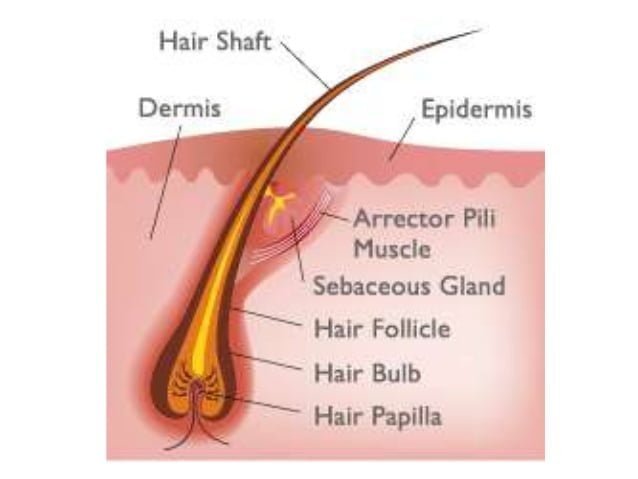
Anatomy of Hair
Parts of the Hair
Dermal Papillae
The dermal papilla is responsible for regulating the hair cycle and hair growth and is also comprised of androgen receptors that are sensitive to the presence of DHT.
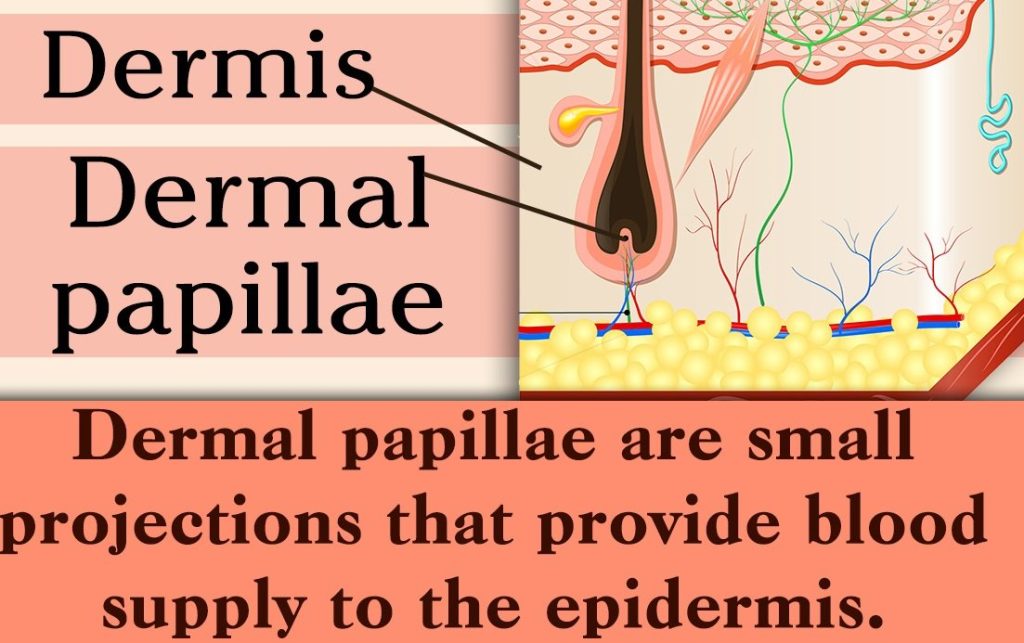
Hair Matrix
The matrix surrounds the dermal papillae and contains all the active cells needed for hair growth and for the development of the different parts of the hair, particularly the outer root sheath, the inner root sheath and the hair shaft. Combined, the matrix and the dermal papillae make up the hair bulb.
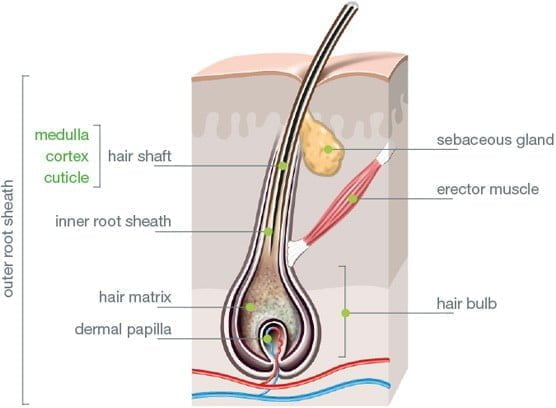
Hair Shaft
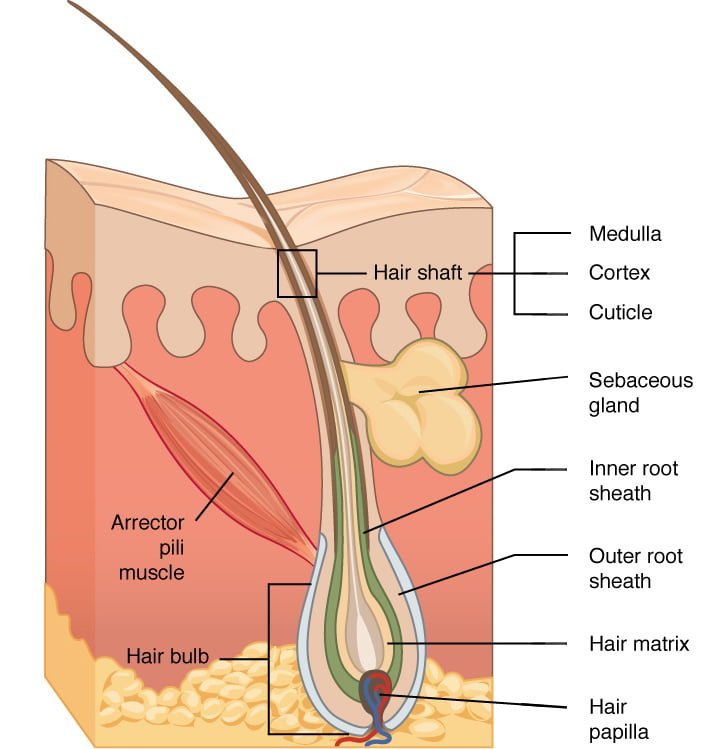
The hair shaft is the solitary part of the hair follicle that fully exits the surface of the skin. The hair shaft is made up of three layers: the medulla, cortex, and the cuticle.
The cuticle is the hair’s outer protective layer and is connected to the internal root sheath. It is a complex structure with a single molecular layer of lipids that helps hair repel water.
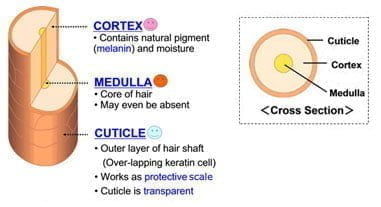
Hair growth occurs in cycles consisting of three phases:
- Anagen (growth phase): Most hair is growing at any given time. Each hair spends several years in this phase.
- Catagen (transitional phase): Over a few weeks, hair growth slows and the hair follicle shrinks.
- Telogen (resting phase): Over months, hair growth stops and the old hair detaches from the hair follicle. A new hair begins the growth phase, pushing the old hair out.
Hair grows at different rates in different people; the average rate is around a one-half inch per month. Hair color is created by pigment cells producing melanin in the hair follicle. With aging, pigment cells die, and hair turns gray.
Various conditions affecting hairs-
Hair Conditions
- Alopecia Areata: Round patches of total hair loss, usually from the scalp. The cause of alopecia is unknown; the hair usually grows back.
- Male Pattern Baldness: The most common type of hair loss in men. Male pattern baldness usually includes either a receding hairline, hair loss at the crown, or both.
- Female Pattern Baldness: In women, hair loss usually includes uniform thinning across the scalp, with a preserved hairline. The crown may be affected, but hair loss rarely proceeds to baldness as in men. See a picture of female pattern baldness.
- Dandruff (seborrheic dermatitis): Ongoing mild inflammation of the scalp, resulting in scaly skin that may be itchy and flake off. Seborrheic dermatitis may also affect the ears and face.
- Tinea Capitis (ringworm): A fungal infection of the scalp, creating round patches of hair loss. Although the patches can appear in a ring shape, no worm is involved in tinea capitis.
- Head lice: Tiny insects that live on the scalp and feed on blood. Preschool and elementary school-aged children and adults who live with children are most susceptible to catching head lice, which are only spread through close contact.
- Hirsutism: A condition in which women develop male-pattern hair (such as facial hair). An excess of testosterone due to a medical condition is usually responsible.
- Folliculitis: Inflammation of hair follicles, usually due to an infection. Staphylococcus aureus is a bacteria that frequently causes folliculitis. An acne is a form of folliculitis that is caused by inflammation. This inflammation can sometimes be worsened by the bacteria Propionibacterium acnes.
Also, Read and Know Do dandruff causes hair loss
A proper examination and consultation are required to treat such kind of diseases. Jaipur skincity provides an end-to-end customized solution as per the patient’s requirements. It may require patience, consistency of the treatment and proper care of the hairs.
Hair wellness is not a one-day miracle. It’s a long-term goal which needs to be achieved by everyone, as hair is the crown of humans which they wear every day.
Also, Read Our Blog On summer hair Care Tips
If you want any hair-related treatment, you can consider Dr Sachin Sharda. He is a highly experienced Dermatologist in Jaipur who provides the best hair-related treatments, like low-level laser therapy, laser hair removal, and hair transplants in jaipur. For those on a budget, he provides laser hair removal and affordable hair transplant cost in Jaipur.


